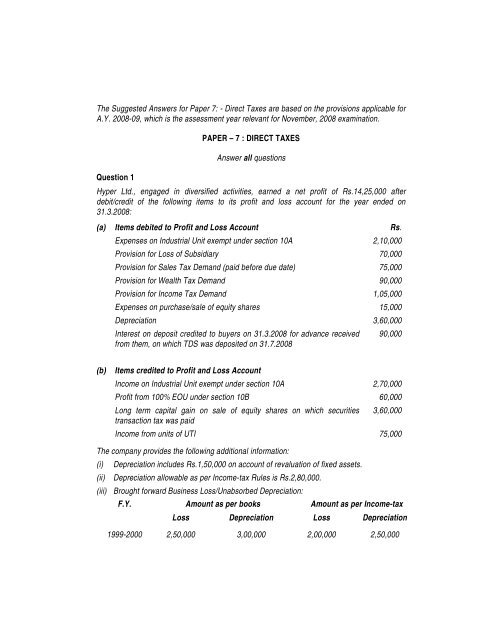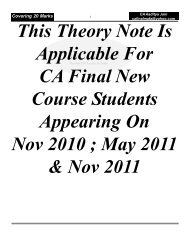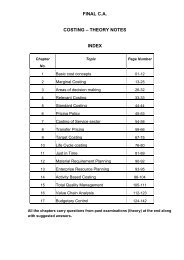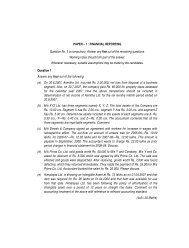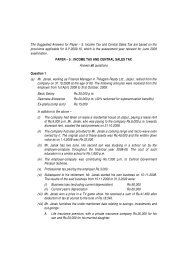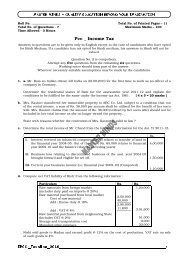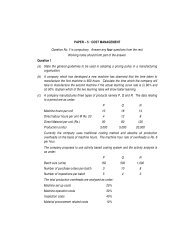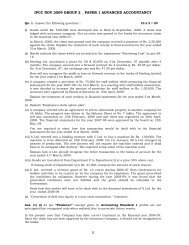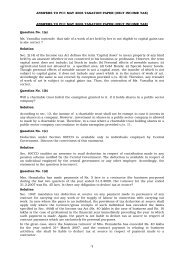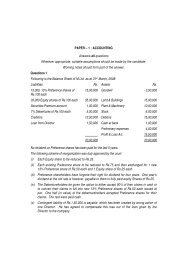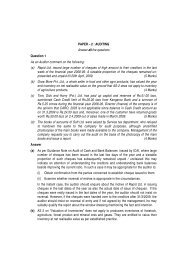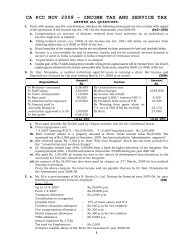The Suggested Answers for Paper 7: - Direct Taxes ... - Master Minds
The Suggested Answers for Paper 7: - Direct Taxes ... - Master Minds
The Suggested Answers for Paper 7: - Direct Taxes ... - Master Minds
Create successful ePaper yourself
Turn your PDF publications into a flip-book with our unique Google optimized e-Paper software.
<strong>The</strong> <strong>Suggested</strong> <strong>Answers</strong> <strong>for</strong> <strong>Paper</strong> 7: - <strong>Direct</strong> <strong>Taxes</strong> are based on the provisions applicable <strong>for</strong><br />
A.Y. 2008-09, which is the assessment year relevant <strong>for</strong> November, 2008 examination.<br />
Question 1<br />
PAPER – 7 : DIRECT TAXES<br />
Answer all questions<br />
Hyper Ltd., engaged in diversified activities, earned a net profit of Rs.14,25,000 after<br />
debit/credit of the following items to its profit and loss account <strong>for</strong> the year ended on<br />
31.3.2008:<br />
(a) Items debited to Profit and Loss Account Rs.<br />
Expenses on Industrial Unit exempt under section 10A 2,10,000<br />
Provision <strong>for</strong> Loss of Subsidiary 70,000<br />
Provision <strong>for</strong> Sales Tax Demand (paid be<strong>for</strong>e due date) 75,000<br />
Provision <strong>for</strong> Wealth Tax Demand 90,000<br />
Provision <strong>for</strong> Income Tax Demand 1,05,000<br />
Expenses on purchase/sale of equity shares 15,000<br />
Depreciation 3,60,000<br />
Interest on deposit credited to buyers on 31.3.2008 <strong>for</strong> advance received<br />
from them, on which TDS was deposited on 31.7.2008<br />
90,000<br />
(b)<br />
Items credited to Profit and Loss Account<br />
Income on Industrial Unit exempt under section 10A 2,70,000<br />
Profit from 100% EOU under section 10B 60,000<br />
Long term capital gain on sale of equity shares on which securities<br />
transaction tax was paid<br />
3,60,000<br />
Income from units of UTI 75,000<br />
<strong>The</strong> company provides the following additional in<strong>for</strong>mation:<br />
(i) Depreciation includes Rs.1,50,000 on account of revaluation of fixed assets.<br />
(ii) Depreciation allowable as per Income-tax Rules is Rs.2,80,000.<br />
(iii) Brought <strong>for</strong>ward Business Loss/Unabsorbed Depreciation:<br />
F.Y. Amount as per books Amount as per Income-tax<br />
Loss Depreciation Loss Depreciation<br />
1999-2000 2,50,000 3,00,000 2,00,000 2,50,000
PAPER – 7 : DIRECT TAXES 51<br />
2004-2005 Nil 2,70,000 1,00,000 1,80,000<br />
2005-2006 3,50,000 3,15,000 1,20,000 2,10,000<br />
You are required to:<br />
(i)<br />
(ii)<br />
Answer<br />
compute the total income of the company <strong>for</strong> the assessment year 2008-09 giving the<br />
reasons <strong>for</strong> treatment of items and<br />
examine the applicability of section 115JB of the Income-tax Act, and compute book<br />
profit and the tax credit to be carried <strong>for</strong>ward. (16 Marks)<br />
Computation of total income of M/s Hyper Ltd. <strong>for</strong> the A.Y. 2008-09<br />
Particulars Rs. Rs.<br />
Net profit as per Profit & Loss Account 14,25,000<br />
Add:Items disallowed /considered separately<br />
Expenses on industrial unit exempt under section 10A [expenses<br />
in relation to exempt income are not be allowed]<br />
Provision <strong>for</strong> loss of subsidiary [since it is not wholly and<br />
exclusively <strong>for</strong> the purpose of business of the assessee]<br />
2,10,000<br />
70,000<br />
Provision <strong>for</strong> wealth-tax [disallowed under section 40(a)(iia)] 90,000<br />
Provision <strong>for</strong> sales tax [is fully allowable since the sales tax has<br />
been paid be<strong>for</strong>e the due date]<br />
Provision <strong>for</strong> income-tax [disallowed under section 40(a)(ii)] 1,05,000<br />
Expenses on transfer of shares [not deductible from business<br />
income. It is to be deducted from gross sale consideration while<br />
computing capital gains]<br />
Interest on deposit credited to buyers on 31.3.2008, but tax<br />
deposited after 2 months i.e. after 31.5.2008 [disallowed under<br />
section 40(a)(ia)]<br />
Depreciation debited to profit and loss account [only depreciation<br />
calculated as per Income-tax Rules is allowable as deduction]<br />
Less:<br />
Items credited but not includible under business<br />
income or are exempt under the provisions of the Act<br />
Income of industrial unit under section 10A, since it is an exempt<br />
income<br />
-<br />
15,000<br />
90,000<br />
3,60,000 9,40,000<br />
2,70,000<br />
Profit from 100% EOU under section 10B, being an exempt income 60,000<br />
23,65,000
52<br />
FINAL EXAMINATION : NOVEMBER, 2008<br />
Long-term capital gain on sale of equity shares on which securities<br />
transaction tax was paid, since it is not a business income. 3,60,000<br />
Income from UTI, since it is not a business income. 75,000<br />
7,65,000<br />
16,00,000<br />
Less: Depreciation (allowable as per Income-tax rules) 2,80,000<br />
Less: Set-off of brought <strong>for</strong>ward business loss and<br />
unabsorbed depreciation<br />
Brought <strong>for</strong>ward business loss under section 72 4,20,000<br />
13,20,000<br />
Brought <strong>for</strong>ward depreciation under section 32 6,40,000 10,60,000<br />
Income from business 2,60,000<br />
Capital Gains<br />
Long term capital gain on sale of equity shares on which securities<br />
transaction tax was paid 3,60,000<br />
Less: Exempt under section 10(38) 3,60,000 Nil<br />
Income from Other Sources<br />
Income from units of UTI 75,000<br />
Less: Exempt under section 10(35) 75,000 Nil<br />
Total Income 2,60,000<br />
Tax payable @ 30% 78,000<br />
Add: Education cess @ 2% 1,560<br />
Secondary and higher education cess @ 1% 780 2,340<br />
Tax Payable as per the Income-tax Act 80,340<br />
Computation of Book Profit under section 115JB<br />
Particulars Rs. Rs.<br />
Net Profit as per Profit & Loss Account 14,25,000<br />
Add: Net Profit to be increased by the following amounts as<br />
per Explanation 1 to section 115JB<br />
Provision <strong>for</strong> loss of subsidiary 70,000
PAPER – 7 : DIRECT TAXES 53<br />
Provision <strong>for</strong> income-tax 1,05,000<br />
Depreciation 3,60,000 5,35,000<br />
Less: Net Profit to be reduced by the following amounts as<br />
per Explanation 1 to section 115JB<br />
Depreciation debited to profit and loss account (excluding<br />
depreciation on account of revaluation of fixed assets) (i.e.<br />
Rs.3,60,000 – Rs.1,50,000)<br />
Income from UTI [since it is an income exempt under section<br />
10(35)]<br />
Brought <strong>for</strong>ward business loss or unabsorbed deprecation as per<br />
books of account, whichever is less, taken on cumulative basis<br />
2,10,000<br />
75,000<br />
19,60,000<br />
6,00,000 8,85,000<br />
Book Profit 10,75,000<br />
10% of book profit 1,07,500<br />
Add: Education cess @ 2% 2,150<br />
Secondary and higher education cess @ 1% 1,075 3,225<br />
1,10,725<br />
In case of a company, it has been provided that where income-tax payable on total income<br />
computed as per the provisions of the Act is less than 10% of book profit, the book profit shall<br />
be deemed as the total income and the tax payable on such total income shall be 10% thereof<br />
plus education cess @2% and secondary and higher education cess @ 1%. Accordingly, in<br />
this case, since income-tax payable on total income computed as per the provisions of the Act<br />
is less than 10% of book profit, the book profit of Rs.10,75,000 is deemed to be the total<br />
income and income-tax is payable @ 10% thereof plus education cess @2% and secondary<br />
and higher education cess @ 1%. <strong>The</strong> tax liability, there<strong>for</strong>e, works out to be Rs.1,10,725.<br />
Section 115JAA provides that where tax is paid in any assessment year in relation to the<br />
deemed income under section 115JB(1), the excess of tax so paid, over and above the tax<br />
payable under the other provisions of the Income-tax Act, will be allowed as tax credit in the<br />
subsequent years. <strong>The</strong> tax credit is, there<strong>for</strong>e, the difference between the tax paid under<br />
section 115JB(1) and the tax payable on the total income computed in accordance with the<br />
other provisions of the Act. This tax credit is allowed to be carried <strong>for</strong>ward <strong>for</strong> seven<br />
assessment years succeeding the assessment year in which the credit became allowable.<br />
Such credit is allowed to be set off against the tax payable on the total income in an<br />
assessment year in which the tax is computed in accordance with the provisions of the Act,<br />
other than section 115JB, to the extent of excess of such tax payable over the tax payable on<br />
book profits in that year.
54<br />
FINAL EXAMINATION : NOVEMBER, 2008<br />
Particulars<br />
Rs.<br />
Tax on book profit under section 115JB 1,10,725<br />
Less: Tax on total income computed as per the other provisions of the Act 80,340<br />
Tax credit to be carried <strong>for</strong>ward 30,385<br />
Notes:<br />
1. Income from industrial unit under section 10A and profit from 100% E.O.U. under<br />
section 10B are exempt from income-tax. However, w.e.f. A.Y.2008-09, MAT is<br />
leviable on income eligible <strong>for</strong> exemption under section 10A and 10B. Hence, such<br />
income should not be reduced while computing book profits and consequently,<br />
expenses relating to such units should not be added back while computing book<br />
profits.<br />
2. Long-term capital gains on sale of equity shares through a recognized stock<br />
exchange on which securities transaction tax (STT) is paid is exempt under sec tion<br />
10(38). One of the adjustments to the book profit is that exempt income under<br />
section 10, which is credited to profit and loss account, would be deducted in arriving<br />
at the book profit. However, w.e.f. A.Y.2007-08, deduction of such long-term capital<br />
gains is not allowed <strong>for</strong> computing book profit. Consequently, expenditure to earn<br />
such income should not be added back to arrive at the book profit. Section 10(38)<br />
also provides that such long term capital gain of a company shall be taken into<br />
account in computing the book profit and income-tax payable under section 115JB.<br />
Question 2<br />
(a)<br />
Ayush, an employee with M/s Isomer Solutions Ltd., provides the following in<strong>for</strong>mation<br />
relating to his income <strong>for</strong> financial year 2007-08:<br />
(i)<br />
(ii)<br />
He received salary Rs.25,000 per month including conveyance allowance @<br />
Rs. 2,500 per month <strong>for</strong> official purposes.<br />
He deposited Rs.2,500 per month in his account under a pension scheme notified<br />
by the Central Government.<br />
(iii) He paid a sum of Rs.60,000 during the year as interest on loan taken in April, 2006<br />
from bank <strong>for</strong> higher studies of his daughter.<br />
(iv)<br />
(v)<br />
He paid health insurance premium <strong>for</strong> himself and <strong>for</strong> his family members Rs.8,500<br />
in cash and Rs.9,000 by credit card.<br />
He invested Rs.40,000 in notified bonds under section 80C issued by NABARD in<br />
July, 2007.
PAPER – 7 : DIRECT TAXES 55<br />
(vi)<br />
Equity shares having fair market price of Rs.1,00,000 were allotted to him by the<br />
company at a concessional price of Rs. 20,000 on 30.5.2007, which were sold by<br />
him <strong>for</strong> Rs.1,80,000 on 28.2.2008.<br />
Compute the total income of Ayush <strong>for</strong> assessment year 2008-09 and give reasons <strong>for</strong><br />
treatment to each of the items.<br />
(6 Marks)<br />
(b)<br />
'X' Ltd., transferred its fertilizer business to a new company ' Y ' Ltd., by way of demerger<br />
with effect from appointed date of 1.4.2007 after satisfying the conditions of demerger.<br />
Further in<strong>for</strong>mation given:<br />
(a)<br />
WDV of the entire block of plant and machinery held by 'X' Ltd. as on 1.4.2007 is<br />
Rs. 100 crores;<br />
(b) Out of the above, WDV of block of plant and machinery of fertilizer division is 70<br />
crores;<br />
(c) 'X' Ltd. has unabsorbed depreciation of Rs.50 lakhs as at 31.3.2007;<br />
On the above facts:<br />
(i)<br />
You are required to explain the provisions of the income-tax as to the allowability of<br />
depreciation, post-merger, in the hands of 'X' Ltd. and 'Y' Ltd. as at 31.3.2008 duly<br />
calculating the depreciation. (4 Marks)<br />
(ii)<br />
Answer<br />
State how the unabsorbed depreciation has to be dealt with <strong>for</strong> the assessment year<br />
2008-09. (3 Marks)<br />
(a) Computation of total income of Mr. Ayush <strong>for</strong> the Assessment Year 2008-09<br />
Salaries<br />
Particulars Rs. Rs.<br />
Gross salary received 3,00,000<br />
Less: Conveyance allowance exempt under section 10(14) 30,000 2,70,000<br />
Capital gains<br />
Sale consideration of equity shares sold on 28.02.2008 1,80,000<br />
Less: Fair Market Price of shares on 30.5.2007 1,00,000<br />
Short-term Capital Gains 80,000<br />
Gross Total Income 3,50,000<br />
Less: Deduction under Chapter VIA<br />
Under section 80C<br />
For investment in notified bonds issued by NABARD 40,000
56<br />
FINAL EXAMINATION : NOVEMBER, 2008<br />
Notes:<br />
(i)<br />
(ii)<br />
(iii)<br />
(iv)<br />
(v)<br />
(vi)<br />
Under section 80CCD<br />
For deposit in pension scheme notified by Central Government<br />
[Rs.30,000 but restricted to 10% of salary i.e. 10% of<br />
Rs.2,70,000]<br />
Under section 80D<br />
27,000<br />
For payment of health insurance premium by credit card 9,000<br />
Under section 80E<br />
For payment of interest on loan taken from bank <strong>for</strong> higher<br />
studies of daughter 60,000 1,36,000<br />
Total Income 2,14,000<br />
Conveyance allowance received <strong>for</strong> official duties is fully exempt under section<br />
10(14).<br />
Section 80CCD provides <strong>for</strong> deduction of employee’s and employer’s contribution to<br />
pension scheme notified by the Central Government. <strong>The</strong> Finance Act, 2007 has<br />
extended this deduction also to individuals employed by any other employer on or<br />
after 1.1.2004. However, if the amount contributed exceeds 10% of salary, then the<br />
deduction would be restricted to 10% of salary.<br />
<strong>The</strong> deduction under section 80E available to an individual in respect of interest on<br />
loan taken <strong>for</strong> his higher education has now been extended by the Finance Act, 2007,<br />
to also include interest on such loan taken <strong>for</strong> higher education of his relative i.e. his<br />
or her spouse and children. Hence, interest on loan taken by Mr. Ayush from bank <strong>for</strong><br />
the higher studies of his daughter is eligible <strong>for</strong> deduction under section 80E.<br />
<strong>The</strong> maximum permissible deduction under section 80D in respect of medical<br />
insurance premium has been increased from Rs.10,000 to Rs.15,000 by the<br />
Finance Act, 2007, and such payment can be made by any mode other than cash.<br />
Hence, payment of Rs.8,500 made in cash will not qualify <strong>for</strong> deduction under<br />
section 80D.<br />
Subscription to notified bonds of NABARD will qualify <strong>for</strong> deduction under section<br />
80C with effect from A.Y.2008-09.<br />
<strong>The</strong> Finance Act, 2007 has widened the fringe benefit tax net. Fringe benefit tax<br />
would be leviable on the employer to the extent of concession given to the<br />
employee while allotting any specified security or sweat equity shares. <strong>The</strong> value of<br />
fringe benefits would be the fair market value of the specified security or sweat<br />
equity shares on the date on which the option vests with employee as reduced by<br />
the amount actually paid by, or recovered from the employee in respect of such<br />
security or shares. Consequently, it has been provided that <strong>for</strong> the purpose of<br />
computing capital gains in the hands of the employee at the time of sale of such<br />
securities/shares by the employee, the cost of acquisition shall be the fair market
PAPER – 7 : DIRECT TAXES 57<br />
value which has been taken into account <strong>for</strong> the purpose of computing the value of<br />
fringe benefits in the hands of the employer.<br />
(b) (i) In the case of a demerger, satisfying the conditions as laid down in section 2(19AA),<br />
the depreciation claim is governed by the provisions as under:<br />
(1) As per the Explanation 7A of section 43(1), where in a scheme of demerger, if<br />
the demerged company transfers any capital asset to the resulting company,<br />
being an Indian company, the actual cost of the capital asset transferred shall<br />
be taken to be the same as it would have been if the demerged company had<br />
continued to hold the capital asset <strong>for</strong> the purpose of its own business.<br />
(2) <strong>The</strong> resulting company will be entitled to depreciation on the written down<br />
value of the block of assets transferred to it, which will be the written down<br />
value of the transferred assets of the demerged company immediately be<strong>for</strong>e<br />
the demerger [Explanation 2B to section 43(6)].<br />
(3) Explanation 2A to section 43(6) provides that the written down value of the<br />
block of assets in the hands of the demerged company shall be the written<br />
down value of the block of assets of the demerged company <strong>for</strong> the<br />
immediately preceding previous year as reduced by the written down value of<br />
the assets transferred to the resulting company pursuant to the demerger.<br />
(4) As per the above provisions, the calculation of depreciation on plant and<br />
machinery in the hands of 'X' Ltd. and 'Y' Ltd. is as under:<br />
WDV of plant and machinery ‘X” Ltd. ‘Y’ Ltd.<br />
Amt. in crores<br />
As at 1 st April, 2007 30.00 70.00<br />
Less: Depreciation @ 15% 4.50 10.50<br />
WDV as at 31 st March, 2008 25.50 59.50<br />
(ii)<br />
Note – It is presumed that Y Ltd. is an Indian company<br />
Set-off of unabsorbed depreciation:<br />
(i)<br />
(ii)<br />
(iii)<br />
As per section 72A(4), on demerger, the unabsorbed depreciation directly<br />
relatable to the undertakings transferred to the resulting company is allowed to<br />
be carried <strong>for</strong>ward and set off in the hands of the resulting company.<br />
Where such unabsorbed depreciation is not directly relatable to the<br />
undertaking transferred to the resulting company, it has to be apportioned<br />
between the demerged company and the resulting company in the same<br />
proportion in which the assets of the undertakings have been retained by the<br />
demerged company and transferred to the resulting company.<br />
<strong>The</strong> demerged company and the resulting company would be allowed to carry<br />
<strong>for</strong>ward and set-off their respective portion of unabsorbed depreciation, as<br />
calculated above, <strong>for</strong> an unlimited period as per section 32(2).
58<br />
FINAL EXAMINATION : NOVEMBER, 2008<br />
Question 3<br />
(a)<br />
Bharat Charitable Trust created on 1.1.2003 applied <strong>for</strong> registration of trust under section<br />
12A of the Income-tax Act be<strong>for</strong>e the Commissioner of Income-tax on 1.7.2007 and<br />
requested <strong>for</strong> condonation of delay.<br />
(i)<br />
(ii)<br />
(iii)<br />
Explain with reasons the period <strong>for</strong> which the trust is eligible to get exemption under<br />
section 11 and 12 of the Income-tax Act.<br />
Can the exemption under sections 11 and 12 <strong>for</strong> assessment year 2008-09 be<br />
denied if the trust is holding investments in equity shares of a public sector<br />
company since 1.4.2005.<br />
<strong>The</strong> Trust has also applied <strong>for</strong> granting exemption under section 80G of the Incometax<br />
Act. But the approval <strong>for</strong> the same has been rejected by the Commissioner of<br />
Income-tax under section 80G(5)(vi) of the Income -tax Act on 30.9.2007. <strong>The</strong> Trust<br />
seeks your advice on whether it can file an appeal against the said rejection be<strong>for</strong>e<br />
the higher authorities. (6 Marks)<br />
(b) Xtra Ltd. gives the following in<strong>for</strong>mation <strong>for</strong> the year ended 31.3.2008:<br />
Answer<br />
- Net Profit as per Profit and Loss Account <strong>for</strong> the financial year 2006-07<br />
Rs.33,00,000 was included in General Reserve.<br />
- On 1.8.2007, the company redeemed its redeemable bonus shares <strong>for</strong> Rs.9,09,000.<br />
- A shareholder holding 10% equity shares of the company borrowed Rs.3,00,000<br />
from the company @ 18% per annum on 31.8.2008.<br />
- <strong>The</strong> company declared dividend of Rs.14,00,000 at its annual general meeting held<br />
on 30.9.2007. But the dividend remained unpaid up to 31.3.2008.<br />
Compute the tax liability of the company under section 115-O (tax on distributed profits)<br />
<strong>for</strong> the A.Y. 2008-09.<br />
Also give reasons <strong>for</strong> treatment of each item. (4 marks)<br />
(a) (i) <strong>The</strong> Finance Act, 2007 has inserted a new sub-section (2) in section 12A providing<br />
that in respect of applications filed on or after 1st June, 2007, the provisions of<br />
section 11 and 12 shall apply in relation to the income of the trust from the<br />
assessment year relevant to the financial year in which the application is made i.e.<br />
the exemption would be available only with effect from the assessment year<br />
relevant to the previous year in which the application is filed. It would not be<br />
available in respect of any earlier assessment year. Further, the power of the<br />
Commissioner to grant registration <strong>for</strong> past years, by condoning the delay in filing<br />
such application, has also been removed.<br />
Hence, Bharat Charitable Trust shall be eligible to get exemption under section 11<br />
and 12 with effect from the financial year 2007-08 only.
PAPER – 7 : DIRECT TAXES 59<br />
(ii)<br />
(iii)<br />
<strong>The</strong> exemption under section 11 and 12 <strong>for</strong> A.Y. 2008-09 cannot be denied to the<br />
trust <strong>for</strong> holding investments in equity shares of a public sector company in<br />
accordance with the amendment by the Finance Act, 2007 in section 13(1)(d)(iii)<br />
denying exemption to a trust holding any shares in a company, other than, inter alia,<br />
shares in a public sector company. <strong>The</strong>re<strong>for</strong>e, a trust cannot be denied exemption<br />
<strong>for</strong> holding shares in a public sector company.<br />
Section 253 has been amended by the Finance Act, 2007 to allow an appeal to be<br />
filed be<strong>for</strong>e the Appellate Tribunal against an order passed by the Commissioner<br />
under section 80G(5)(vi) rejecting the app lication of such trusts <strong>for</strong> the purpose of<br />
recognition under section 80G.<br />
(b) Computation of tax liability of Xtra Ltd. under section 115-O <strong>for</strong> the A.Y. 2008-09<br />
Particulars<br />
Redemption of Bonus Shares [See Note 1 below] 9,09,000<br />
Dividend declared at AGM [See Note 3 below] 14,00,000<br />
Taxable Dividend 23,09,000<br />
Tax payable on distributed profits under section 115-O<br />
[Rs.23,09,000×16.995%] [See Note 4 below]<br />
Notes –<br />
Rs.<br />
3,92,415<br />
(1) It is assumed that the bonus shares are in the <strong>for</strong>m of redeemable preference<br />
shares, since only then would redemption be possible. If such bonus shares are<br />
issued to equity shareholders, it does not amount to distribution of dividend at the<br />
time of issue of bonus shares, as there is no release of assets. However, when<br />
bonus shares are redeemed, there will be release of assets and in that event it<br />
would constitute dividend under section 2(22)(a).<br />
(2) Borrowing by a shareholder holding 10% equity shares of the company is deemed<br />
dividend under section 2(22)(e), taxable in the hands of shareholder during the<br />
P.Y.2008-09. <strong>The</strong>re<strong>for</strong>e, the company is not liable to pay any tax on it.<br />
(3) <strong>The</strong> tax on distributed profits shall be paid within 14 days from the date of<br />
declaration or distribution or payment of any dividend, whichever is earliest.<br />
<strong>The</strong>re<strong>for</strong>e, in this case, the dividend distribution tax is payable within 14 days of the<br />
declaration though dividend is not actually paid up to 31.03.2008.<br />
(4) <strong>The</strong> Finance Act, 2007 has raised the rate of tax on distributed profits to 15% in<br />
respect of any amount declared, distributed or paid by a domestic company by way<br />
of dividends [Section 115-O]. <strong>The</strong> effective rate of tax (including surcharge@10%,<br />
education cess@2% and secondary and higher education cess@1%) is 16.995%.
60<br />
FINAL EXAMINATION : NOVEMBER, 2008<br />
Question 4<br />
Discuss the correctness or otherwise of the following propositions in the context of the<br />
Income-tax Act, 1961:<br />
(a)<br />
(b)<br />
(c)<br />
(d)<br />
Answer<br />
(a)<br />
(b)<br />
A fresh claim be<strong>for</strong>e the Assessing Officer can be made only by filing a revised return<br />
and not otherwise.<br />
<strong>The</strong> powers of the Commissioner of Income-tax (Appeals) to enhance the assessment<br />
are plenary and quite wide.<br />
At the time of hearing of rectification application, the Income-tax Appellate Tribunal can<br />
re-appreciate the evidence produced during the proceedings of the appeal hearing.<br />
<strong>The</strong> High Court cannot interfere with the factual finding recorded by the lower authorities<br />
and the tribunal, without any valid reasons.<br />
(4 × 4 = 16 Marks)<br />
This proposition is correct. A return of income filed within the due date may be<br />
revised by filing a revised return under section 139(5) where the assessee finds any<br />
omission or wrong statement in the original return subject to satisfying other<br />
conditions. <strong>The</strong>re is no provision in the Income-tax Act to make changes or<br />
modification in the return of income by filing a letter. In a case where a return of<br />
income has been filed within the due date, the only option available to the assessee<br />
to make an amendment to such return is by way of filing a revised return under<br />
section 139(5). <strong>The</strong>re<strong>for</strong>e, a fresh claim can be made be<strong>for</strong>e the Assessing Officer<br />
only by filing a revised return and not otherwise.<strong>The</strong> Supreme Court in Goetze (India)<br />
Ltd. vs. CIT (2006) 284 ITR 323 has held that there was no provision in the Incometax<br />
Act to allow an amendment in the return of income filed except by way of filing a<br />
revised return.<br />
<strong>The</strong> proposition is correct in law. <strong>The</strong> Supreme Court has, in CIT vs. McMilan & Co.<br />
(1958) 33 ITR 182 and CIT vs. Kanpur Industrial Syndicate (1964) 53 ITR 225 , held<br />
that in disposing of an appeal be<strong>for</strong>e him, the appellate authority can travel over a<br />
whole range of the assessment order. <strong>The</strong> scope of his powers is co-terminus with<br />
that of the Assessing Officer. He can do what the Assessing Officer can do and can<br />
also direct him to do what he has failed to do. He can assess income from sources<br />
which have been considered by the Assessing Officer but not brought to tax. He can<br />
consider every aspect of the assessment order and give appropriate reliefs.<br />
<strong>The</strong> Allahabad High Court has, in CIT v. Kashi Nath Chandiwala (2006) 280 ITR 318 ,<br />
held that the appellate authority is empowered to consider and decide any matter<br />
arising out of the proceedings in which the order appealed against was passed<br />
notwithstanding the fact that such matter was not raised be<strong>for</strong>e him by the assessee.<br />
<strong>The</strong> Commissioner (Appeals) is entitle d to direct additions in respect of items of<br />
income not considered by the Assessing Officer.
PAPER – 7 : DIRECT TAXES 61<br />
(c)<br />
(d)<br />
Further, the Apex Court has, in the case of Jute Corporation of India Ltd. vs. CIT (1991)<br />
187 ITR 688, held that the appellate authority is vested with all the plenary powers which<br />
the subordinate authority may have in the matter. He also has the jurisdiction to permit<br />
the appellant to raise an additional ground, if the ground became available subsequently<br />
because of change in law or because of change in circumstances and such ground could<br />
not have been raised at the time of filing the return or at the time of making an<br />
assessment. He must be satisfied that the ground raised is bona fide and that the same<br />
could not have been raised earlier <strong>for</strong> good reasons.<br />
Thus, the powers of the appellate authority in enhancing the assessment are very<br />
wide and plenary.<br />
<strong>The</strong> proposition is not correct as per law. This is because section 254(2) specifically<br />
empowers the Appellate Tribunal to amend any order passed by it, either suo-moto<br />
or on an application made by the assessee or Assessing Officer, with a view to<br />
rectifying any mistake apparent from record, at any time within 4 years from the date<br />
of the order sought to be amended.<br />
<strong>The</strong> powers of the tribunal under section 254(2) relating to rectification of its order<br />
are very limited. Such powers are confined to rectifying any mistake apparent from<br />
the record. <strong>The</strong> mistake has to be such that <strong>for</strong> which no elaborate reasons or<br />
inquiry is necessary. Accordingly, the re-appreciation of evidence placed be<strong>for</strong>e the<br />
Tribunal during the course of the appeal hearing is not permitted. It cannot readjudicate<br />
the issue afresh under the garb of rectification. This issue came up <strong>for</strong><br />
consideration be<strong>for</strong>e the Punjab & Haryana High Court in the case of CIT vs.<br />
Vardhman Spinning (1997) 226 ITR 296. <strong>The</strong> Court observed that the jurisdiction to<br />
review or modify orders passed by the authorities under the Act cannot be inferred<br />
on the basis of a supposed inherent right.<br />
<strong>The</strong> proposition is correct in law. A finding of fact cannot be disturbed by the High<br />
Court in exercise of its powers under section 260A. <strong>The</strong> Income-tax Appellate<br />
Tribunal is a fact finding authority and the findings of fact recorded by the Tribunal<br />
can be interfered with by the High Court under section 260A only on the ground that<br />
the same were without evidence or material, or if the finding is contrary to the<br />
evidence, or is perverse or there is no direct nexus between conclusion of fact and<br />
the primary fact upon which that conclusion is based.<br />
In CIT vs. P. Mohanakala (2007) 291 ITR 278 and Commissioner of Agricultural incometax<br />
vs. M.N.Moni (2007) 291 ITR 387, the Apex Court observed that the High Court had<br />
set aside the factual findings of the lower authorities and the Tribunal without any valid<br />
reason. <strong>The</strong> Apex Court held that the findings of fact could not be interfered with by the<br />
High Court without carefully considering the facts on record, the surrounding<br />
circumstances and the material evidence. <strong>The</strong>re is no scope <strong>for</strong> interference with the<br />
factual findings, unless the findings are per se without reason or basis, perverse and/or<br />
contrary to the material on record.
62<br />
FINAL EXAMINATION : NOVEMBER, 2008<br />
Question 5<br />
(a)<br />
(b)<br />
(c)<br />
Answer<br />
(a)<br />
(b)<br />
<strong>The</strong> Commissioner of Income-tax issued notice to revise the order passed by an<br />
Assessing Officer under section 143. During the pendency of proceedings be<strong>for</strong>e the<br />
Commissioner, on the basis of material gathered during survey under section 133A, the<br />
Commissioner of Income-tax issued a second notice, the contents of which were different<br />
from the contents of the first notice. State with reasoning whether the action of the<br />
Commissioner is justified as to the second notice.<br />
(3 Marks)<br />
State the circumstances where the appellant shall be entitled to produce additional<br />
evidence, oral or documentary, be<strong>for</strong>e the Commissioner of Income-tax (Appeals) other<br />
than the evidence produced during the proceedings be<strong>for</strong>e the Assessing Officer.<br />
(3 Marks)<br />
In the context of transfer pricing provisions, read with rules, what are the factors to be<br />
considered while selecting the most appropriate method?<br />
(6 Marks)<br />
<strong>The</strong> action of the Commissioner in issuing the second notice is not justified. <strong>The</strong> term<br />
“record” has been defined in clause (b) of Explanation to section 263(1). According<br />
to this definition “record” shall include and shall be deemed always to have included<br />
all records relating to any proceeding under the Act available at the time of<br />
examination by the Commissioner. In other words, the in<strong>for</strong>mation, material, report<br />
etc. which were not in existence at the time the assessment was made and came into<br />
existence afterwards can be taken into consideration by the Commissioner <strong>for</strong> the<br />
purpose of invoking his jurisdiction under section 263(1). However, at the same time,<br />
in view of the express provisions contained in clause (b) of the Explanation to section<br />
263(1), such in<strong>for</strong>mation, material, report etc. can be relied upon by the<br />
Commissioner only if the same <strong>for</strong>ms part of record when the action under section<br />
263 is taken by the Commissioner,<br />
Issuance of a notice under section 263 succeeds the examination of record by<br />
Commissioner. In the present case, the Commissioner initially issued a notice under<br />
section 263, after the examination of the record available be<strong>for</strong>e him. <strong>The</strong><br />
subsequent second notice was on the basis of material collected under section 133A,<br />
which was totally unrelated and irrelevant to the issues sought to be revised in the<br />
first notice. Accordingly, the material on the basis of which the second notice was<br />
issued could not be said to be “record” available at the time of examination as<br />
emphasised in Explanation (b) to section 263(1).<br />
As per Rule 46A(1) of the Income -tax Rules 1962, an appellant shall be entitled to<br />
produce be<strong>for</strong>e the Commissioner (Appeals), evidence, either oral or documentary,<br />
other than the evidence produced by him during the course of proceedings be<strong>for</strong>e the<br />
Assessing Officer, only in the following circumstances -
PAPER – 7 : DIRECT TAXES 63<br />
(c)<br />
(a)<br />
(b)<br />
(c)<br />
(d)<br />
where the Assessing Officer has refused to admit evidence which ought to have<br />
been admitted; or<br />
where the appellant was prevented by sufficient cause from producing the evidence<br />
which he was called upon to produce by the Assessing Officer; or<br />
where the appellant was prevented by sufficient cause from producing be<strong>for</strong>e the<br />
Assessing Officer any evidence which is relevant to any ground of appeal; or<br />
where the Assessing Officer has made the order appealed against without giving<br />
sufficient opportunity to the appellant to adduce evidence relevant to any ground of<br />
appeal.<br />
Rule 10C deals with the determination of the most appropriate method. Under this<br />
Rule, the method which is best suited to the facts and circumstances of each<br />
particular international transaction, and which provides the most reliable measure of<br />
an arm's length price in relation to the international transaction will be considered as<br />
the most appropriate method.<br />
For the purpose of selecting the most appropriate method, the following factors<br />
should be taken into account -<br />
(i) the nature and class of the international transaction;<br />
(ii)<br />
(iii)<br />
(iv)<br />
(v)<br />
(vi)<br />
Question 6<br />
(a)<br />
the class or classes of associated enterprises entering into the transaction and the<br />
functions per<strong>for</strong>med by them taking into account assets employed or to be<br />
employed and risks assumed by such enterprises;<br />
the availability, coverage and reliability of data necessary <strong>for</strong> application of the<br />
method;<br />
the degree of comparability existing between the international transaction and the<br />
uncontrolled transaction and between the enterprises entering into such<br />
transactions;<br />
the extent to which reliable and accurate adjustments can be made to account <strong>for</strong><br />
differences, if any, between the international transaction and the comparable<br />
uncontrolled transaction or between the enterprises entering into such transactions;<br />
the nature, extent and reliability of assumptions required to be made in application<br />
of a method.<br />
P Ltd. is engaged in manufacture of a product. It paid a lump-sum deposit and obtained<br />
50 mobile phone services so that the employees of the assessee can be contacted<br />
immediately. <strong>The</strong> company paid Rs.45,000 every month towards the service and call<br />
charges to the mobile phone franchise. On these facts:<br />
(i)<br />
Whether P Ltd. has to deduct tax at source on the payment?<br />
(ii) If so, under which provisions of the Act? (3 Marks)
64<br />
FINAL EXAMINATION : NOVEMBER, 2008<br />
(b)<br />
R Ltd. paid Rs.5 lakhs as sales commission to Mr. Francis (non -resident), who acted as<br />
its agent <strong>for</strong> booking orders from various customers who are outside India. <strong>The</strong> assessee<br />
has not deducted tax at source on the commission payment <strong>for</strong> the year ended<br />
31.3.2008. On these facts:<br />
(i)<br />
(ii)<br />
Answer<br />
(a)<br />
Decide whether the commission is chargeable to tax in the hands of Mr. Francis in<br />
India.<br />
Decide about the deductibility of the commission payment in the assessment of R<br />
Ltd. (4 Marks)<br />
In this case, the assessee pays the service and call charges every month to a mobile<br />
phone franchise. Explanation 2 to section 9(1)(vii) provides that “fees <strong>for</strong> technical<br />
services” means any consideration (including any lump sum consideration) <strong>for</strong> the<br />
rendering of any managerial, technical or consultancy services (including the<br />
provision of services of technical or other personnel). <strong>The</strong>re<strong>for</strong>e, mere collection of<br />
fee by the mobile phone franchise from the customers <strong>for</strong> use of mobile phone<br />
services will not amount to receipt of fees towards technical services. When a<br />
subscriber pays money to the mobile phone franchise, it is towards the benefit of<br />
availing the services to communicate with others and not <strong>for</strong> any technical services.<br />
<strong>The</strong> payment made is <strong>for</strong> the use of airtime. Installation of technical equipment to<br />
ensure connectivity to the subscriber cannot make it technical services. <strong>The</strong>re<strong>for</strong>e, P<br />
Ltd. does not have to deduct tax at source under section 194J on the payments made<br />
to the mobile phone franchisee towards the service and call charges. This view was<br />
upheld by the Madras High Court in Skycell Communications Ltd. v. Dy. CIT (2001)<br />
251 ITR 53.<br />
(b) (i) A <strong>for</strong>eign agent of an Indian exporter operates in his own country and no part of his<br />
income arises in India. His commission is usually remitted directly to him and is,<br />
there<strong>for</strong>e, not received by him or on his behalf in India. Such an agent is not liable<br />
to income-tax in India on the commission. This has been clarified in Circular No.23,<br />
dated 23.7.1969. In view of the specific circular, the commission paid to the nonresident<br />
agent of the Indian exporter <strong>for</strong> services rendered outside India is not<br />
chargeable to tax in India <strong>for</strong> the A.Y. 2008-09.<br />
(ii)<br />
Section 40(a)(i) requires deduction of tax at source in respect of any interest,<br />
royalty, fees <strong>for</strong> technical services or other sum chargeable under this Act, which is<br />
payable outside India or in India to a non-resident. However, in this case, the<br />
commission payable to the non-resident agent is not chargeable to income-tax in<br />
view of the clarification given by Circular No.23 dated 23.7.1969 explained in (i)<br />
above. Further, Circular No.786 dated 7.2.2000 clarifies that, in such a case, no tax<br />
is required to be deducted at source under section 195. Hence, disallowance under<br />
section 40(a)(i) would not be attracted, and the commission payment would be<br />
deductible in the assessment of R Ltd.
PAPER – 7 : DIRECT TAXES 65<br />
Question 7<br />
(a)<br />
Zeta (India) Ltd., a non-resident company dealing in consumer products and having their<br />
employee base in India, has furnished the following in<strong>for</strong>mation <strong>for</strong> the year ended on<br />
31.3.2008:<br />
(i)<br />
(ii)<br />
(iii)<br />
(iv)<br />
(v)<br />
Expenditure on <strong>for</strong>eign travelling Rs.1,80,000.<br />
Expenditure on display of its products Rs.3,60,000.<br />
Expenditure on distribution of free samples Rs.2,40,000.<br />
Expenditure on providing transport facility <strong>for</strong> movement of offshore employees from<br />
their residence in home countries (outside India) to place of work (rigs in India) and<br />
back Rs.6,30,000.<br />
<strong>The</strong> company granted to its 300 employees, options to buy 200 sweat equity shares<br />
of the company over a period of two years at Rs.100 per share on 1.6.2007. Out of<br />
which 250 employees exercised their option to buy 50% shares by 31.12.2007 and<br />
balance 50% shares after 1.6.2008. <strong>The</strong> Fair Market Price of shares as on 1.6.2007<br />
was Rs.200 per share.<br />
Calculate the fringe benefit tax liability of the company <strong>for</strong> Assessment Year 2008-09<br />
along with due dates and amount of advance fringe benefit tax payable under section<br />
115WJ of the Income-tax Act. Reasons <strong>for</strong> treatment of each of the above items should<br />
<strong>for</strong>m part of your answer. (8 Marks)<br />
(b) Explain as to what the term 'Advance Ruling' means under the Income-tax Act 1961.<br />
(c)<br />
Answer<br />
(a)<br />
(4 Marks)<br />
State the circumstances under which a certificate can be issued by the Assessing Officer<br />
to the Tax Recovery Officer.<br />
(4 Marks)<br />
Computation of fringe benefit tax liability of M/s Zeta (India) Ltd. <strong>for</strong> the A.Y.<br />
2008-09.<br />
Amount<br />
(Rs.)<br />
% of<br />
expenditure<br />
to be treated<br />
as value of<br />
fringe<br />
benefit<br />
Value of<br />
fringe<br />
benefit<br />
(Rs.)<br />
(i) Expenditure of <strong>for</strong>eign traveling 1,80,000 5% 9,000<br />
(ii) Expenditure on display of products 3,60,000 - -<br />
(iii) Expenditure on distribution of free samples 2,40,000 - -
66<br />
FINAL EXAMINATION : NOVEMBER, 2008<br />
(iv) Expenditure on providing transport facility<br />
<strong>for</strong> movement of offshore employees from<br />
their residence in home countries (outside<br />
India) to place of work (rigs in India) and<br />
back<br />
(v) Sweat equity shares transferred to<br />
employees during the year at a<br />
concessional price<br />
6,30,000 - -<br />
25,00,000 100% 25,00,000<br />
Total value of fringe benefits 25,09,000<br />
FBT payable @ 30% 7,52,700<br />
Add: Surcharge @ 2.5% 18,818<br />
7,71,518<br />
Add: Education cess@ 2% 15,430<br />
Secondary and higher education cess@1% 7,715 23,145<br />
Total FBT payable 7,94,663<br />
Total FBT payable (rounded off) 7,94,660<br />
Advance FBT payable under section 115WJ<br />
Due date of<br />
installment<br />
Installments payable<br />
Advance FBT payable<br />
Rs.<br />
On or be<strong>for</strong>e 15 th<br />
June, 2007<br />
Not less than 15% of such<br />
advance tax.<br />
15% of Rs.7,94,660 = 1,19,200<br />
On or be<strong>for</strong>e 15 th<br />
September, 2007<br />
Not less than 45% of such<br />
advance tax, as reduced by<br />
the amount, if any, paid in<br />
the earlier installment.<br />
45% of Rs.7,94,660 -<br />
Rs.1,19,200 =<br />
Rs.3,57,600 - Rs.1,19,200 = 2,38,400<br />
On or be<strong>for</strong>e 15 th<br />
December, 2007<br />
Not less than 75% of such<br />
advance tax, as reduced by<br />
the amount or amounts, if<br />
any, paid in the earlier<br />
installment or installments.<br />
75% of Rs.7,94,660 -<br />
(Rs.1,19,200+Rs.2,38,400)<br />
=Rs.5,96,000 – Rs.3,57,600 = 2,38,400
PAPER – 7 : DIRECT TAXES 67<br />
On or be<strong>for</strong>e the<br />
15 th March, 2008<br />
<strong>The</strong> whole amount of such<br />
advance tax as reduced by<br />
the amount or amounts, if<br />
any, paid in the earlier<br />
installment or installments.<br />
Rs.7,94,660 – (Rs.1,19,200<br />
+Rs.2,38,400+Rs.2,38,400) =<br />
Rs.7,94,660 – Rs.5,96,000 = 1,98,660<br />
Notes:<br />
(i) Expenditure on tour and travel including <strong>for</strong>eign travel is liable <strong>for</strong> FBT @ 5% .<br />
(ii)<br />
(iii)<br />
(iv)<br />
(v)<br />
Expenditure on display of products has been excluded from 'Sales promotion<br />
including publicity' by the Finance Act, 2007 and hence, is exempt from FBT from<br />
A.Y.2008-09.<br />
Expenditure on distribution of free samples has now been excluded from 'Sales<br />
promotion including publicity' by the Finance Act, 2007 and hence, such expenditure<br />
is exempt from FBT <strong>for</strong> A.Y. 2008-09.<br />
<strong>The</strong> expenditure incurred by the company on providing free or subsidised<br />
transport facility <strong>for</strong> movement of offshore employees from their residence in<br />
home countries (outside India) to their place of work (rigs in India) does not<br />
attract FBT. This has been held by the Supreme Court in R & B Falcon (A)(P.)<br />
Ltd. v. CIT (2008) 301 ITR 309.<br />
FBT liability has also been extended to sweat equity shares allotted or transferred,<br />
directly or indirectly, by the employer, free of cost or at a concessional rate, to his<br />
employees, including <strong>for</strong>mer employees, by insertion of a new clause (d) in section<br />
115WB(1) by the Finance Act, 2007. <strong>The</strong> value of fringe benefit is the fair market<br />
value on the date on which the option vests with the employee as reduced by the<br />
amount actually paid by, or recovered from, the employee in respect of such shares.<br />
Hence, the taxable fringe benefit in respect of options exercised during the financial<br />
year 2007-08 is calculated as under:<br />
Fair market value of 100 shares as on 1.6.2007<br />
i.e. the date of vesting of option<br />
Rs.<br />
= 250×100×200 = 50,00,000<br />
Less: Amount recovered from employees = 250×100×100 = 25,00,000<br />
Taxable value of fringe benefit <strong>for</strong> A.Y. 2008-09 25,00,000<br />
(b) <strong>The</strong> term ‘advance ruling’ has been defined in section 245N(a) to mean : -<br />
(a)<br />
a determination by the Authority in relation to a transaction which has been<br />
undertaken or is proposed to be undertaken by a non-resident applicant; or
68<br />
FINAL EXAMINATION : NOVEMBER, 2008<br />
(c)<br />
(b)<br />
(c)<br />
a determination by the Authority in relation to the tax liability of a non-resident<br />
arising out of a transaction which has been undertaken or is proposed to be<br />
undertaken by a resident applicant with such non-resident,<br />
and such determination shall include the determination of any question of law or of<br />
fact specified in the application;<br />
a determination or decision by the Authority in respect of an issue relating to<br />
computation of total income which is pending be<strong>for</strong>e any income-tax authority or<br />
the Appellate Tribunal and such determination or decision shall include the<br />
determination or decision on any question of law or of fact relating to such<br />
computation of total income specified in the application.<br />
<strong>The</strong> assessee is required to pay the tax due as per the notice of demand issued under<br />
section 156 within 30 days of the service of notice. If the amount is not paid within 30<br />
days, then it could be recovered as per the provisions of sections 222 to 227, 229 and<br />
232 of the Income-tax Act. Where the assessee has not paid the tax due within the<br />
specified period, the Assessing Officer may issue a certificate to the Tax Recovery<br />
Officer <strong>for</strong> initiating recovery proceedings in the following circumstance –<br />
(a) where the assessee has not filed an appeal be<strong>for</strong>e Commissioner (Appeals) or<br />
Appellate Tribunal; and<br />
(b)<br />
has also not made any request <strong>for</strong> extension of time <strong>for</strong> payment of tax.<br />
As per the provisions of section 222, when an assessee is in default or is deemed to be<br />
in default in making a payment of tax, the Tax Recovery Officer may draw up under his<br />
signature a statement in the prescribed <strong>for</strong>m specifying the amount of arrears due from<br />
the assessee. Such statement is referred to as “certificate”. He shall proceed to recover<br />
from such assessee the amount specified in the certificate by one or more of the modes<br />
mentioned below, in accordance with the rules laid down in the Second Schedule -<br />
(a) attachment and sale of the assessee's movable property;<br />
(b)<br />
(c)<br />
(d)<br />
attachment and sale of the assessee's immovable property;<br />
arrest of the assessee and his detention in person;<br />
appointing a receiver <strong>for</strong> the management of assessee's movable and immovable<br />
properties.<br />
<strong>The</strong> Tax Recovery Officer may have recourse to any of the above measures<br />
notwithstanding that proceedings <strong>for</strong> recovery of the arrears by any other mode have<br />
already been taken.<br />
Question 8<br />
(a)<br />
Matisha Constructions Ltd. furnishes the following particulars of its wealth <strong>for</strong> the<br />
valuation date as on 31.3.2008:
PAPER – 7 : DIRECT TAXES 69<br />
Rs.in lacs<br />
(i) Land in urban area (held as stock in trade since 1996). 81<br />
(ii)<br />
(iii)<br />
(iv)<br />
Motor cars (including one imported car, worth Rs.18 lacs used <strong>for</strong><br />
hiring)<br />
250 acres agricultural land acquired at Greater Noida Township on<br />
27.8.2007 <strong>for</strong> construction of residential flats/commercial complex.<br />
However, Greater Noida Authority has reserved 25 acres land as<br />
green belt.<br />
Residential flats of 1500 sq feet each provided to 3 employees<br />
(salary of one employee exceeded Rs.5 lacs per annum) 36<br />
(v) Farm house of 5 acre at a remote village 9<br />
(vi) Cash in hand as per cash book 3<br />
38<br />
250<br />
(b)<br />
Answer<br />
Liabilities:<br />
(i) Loan <strong>for</strong> purchase of land at Urban area 30<br />
(ii) Loan <strong>for</strong> purchase of land at Greater Noida 120<br />
(iii) Wealth-tax liability <strong>for</strong> Assessment year 2007-08 12<br />
(iv) Loan <strong>for</strong> construction of residential flats 9<br />
Compute the net wealth of the company <strong>for</strong> assessment year 2008-09. (8 Marks)<br />
Mr. X, a member of co-operative housing society, was allotted a plot as per the bylaws of<br />
the society. He constructed a house on plot and substituted the name of his wife in the<br />
records of the society in his place. <strong>The</strong> society executed the registered sale deed in<br />
respect of said plot in favour of his wife. <strong>The</strong> Assessing Officer included the value of the<br />
said property in the hands of Mr. X. Examine the validity of the action of the Assessing<br />
Officer. (2 Marks)<br />
(a) Computation of Net Wealth of M/s Matisha Constructions Ltd. <strong>for</strong> A.Y. 2008-09<br />
Particulars Rs. in<br />
lacs<br />
Assets [as per the definition of assets under section 2(ea)]<br />
(i)<br />
(ii)<br />
Land in urban area (held as stock in trade since 1996) – taxable since<br />
it is held as stock-in-trade <strong>for</strong> more than 10 years<br />
Motor cars (excluding imported car not being an asset since it is used<br />
<strong>for</strong> hiring) [38 lac – 18 lac]<br />
81<br />
20
70<br />
FINAL EXAMINATION : NOVEMBER, 2008<br />
(iii) Agricultural land acquired <strong>for</strong> construction of residential and<br />
commercial complex (is a stock -in-trade in the hands of a<br />
construction company – hence, not an asset)<br />
(iv) (a) Residential flats provided to 2 employees drawing salary less<br />
than Rs.5 lacs per annum – not an asset<br />
(v)<br />
(vi)<br />
Less:<br />
(i)<br />
(b)<br />
Residential flat provided to one employee drawing salary<br />
exceeding Rs.5 lacs per annum is an asset [36 × 1/3]<br />
Farm house at a remote village is not an asset (assuming that it is not<br />
situated within 25 km from the local limits of any municipality)<br />
Cash in hand as per cash book is not an asset since it represents<br />
cash recorded in the books<br />
Liabilities<br />
Loan <strong>for</strong> purchase of land in urban area – deductible, since it is<br />
incurred in relation to land in urban area, which is an asset<br />
chargeable to wealth-tax.<br />
(ii) Loan <strong>for</strong> purchase of agricultural land - not deductible, since<br />
land is not an asset<br />
(iii)<br />
(iv)<br />
Wealth Tax liability <strong>for</strong> Assessment year 2007-08 – wealth tax<br />
liability is not deductible<br />
Loan <strong>for</strong> construction of residential flats - the portion relating to<br />
1<br />
taxable asset (1/3) is deductible i.e. 9 lacs<br />
3<br />
3 33<br />
Net Wealth 80<br />
30<br />
Nil<br />
Nil<br />
Nil<br />
Nil<br />
12<br />
Nil<br />
Nil<br />
113<br />
(b) <strong>The</strong> Allahabad High Court has, in the case of Ram Saran Das Tandon v. CWT (2007)<br />
292 ITR 546, held that when the assessee has ceased to be a member of the society,<br />
he could not be treated as the owner of the house property. <strong>The</strong>re<strong>for</strong>e, the value of<br />
the property is not assessable in his hands.<br />
In this case, assuming that Mr.X has received adequate consideration from his wife<br />
Mrs.X <strong>for</strong> the transfer, the action of the Assessing Officer in including the value of said<br />
property in the hands of Mr. X is not valid.


